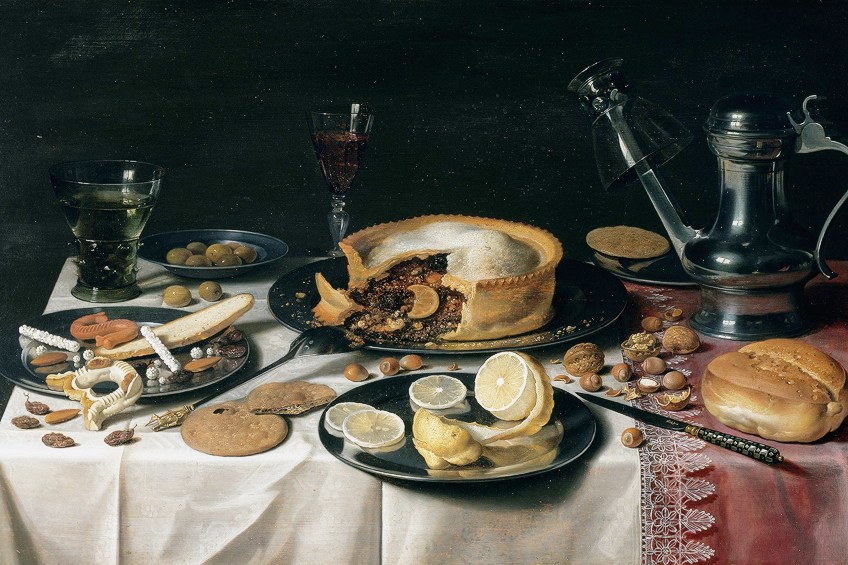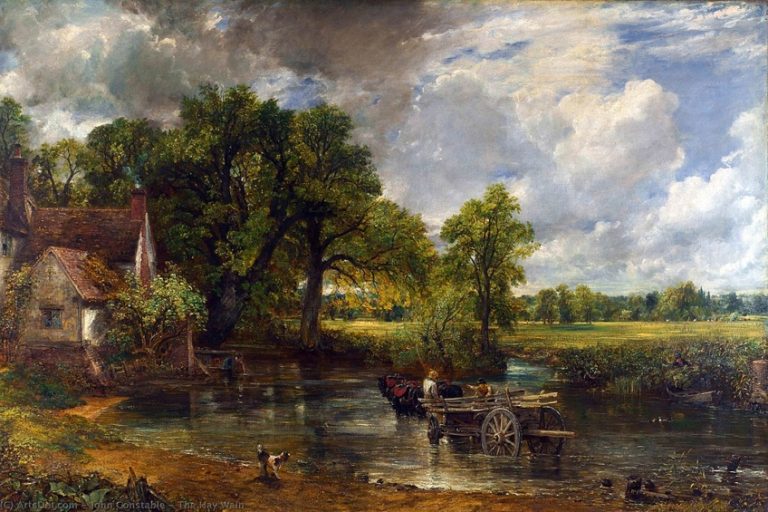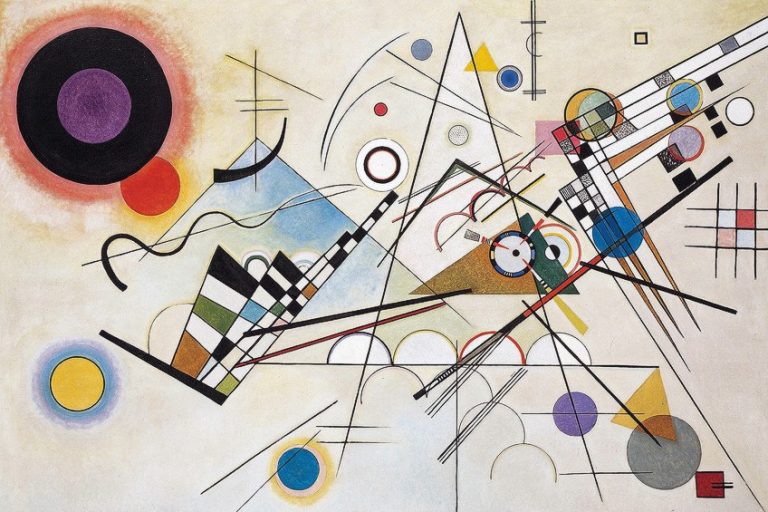Texture in Art – Exploring the Element of Texture in Art
Have you ever observed a painting from afar and wondered how the artist managed to render such elegant and polished brush strokes? or perhaps you may have noticed the expert handling of how an artist created such a realistic surface quality. Texture is everywhere we look and in this article, we will discuss the definition of texture in art, as well as its purpose and various texture art examples that will help you better understand this important art element.
Table of Contents
Defining Texture in Art
Modern texture art definitions include various descriptions of the function and significance of incorporating texture into your artwork. The concept and term “texture” relate to the surface quality of an artwork. The surface quality we speak of refers to the visual look and feel of a subject or object’s surface in an image.
As such, this is understood as the texture, which can be created using a variety of mark-making techniques. Whether you are creating a drawing, sculpture, or painting, texture can be created and identified in almost any artwork.
This brings us to another important term related to texture and that is “feeling”.
The texture in a painting or sculpture allows us to feel and perceive the artwork, which can feel or look smooth, rough, glossy, or matte in terms of its surface finish. It is of general consensus that most people cannot simply walk into a gallery and physically touch the artwork to gauge its texture since texture is related to the tactile sense of touch, which we use to perceive texture.
Hence, artists have to employ visual techniques and strategies in art production to ensure that the viewer is able to grasp the texture of an object or image and imagine how the subject must feel. From three-dimensional works of art like sculptures that carry smooth surfaces to textured paintings that display the intentional application of layers of paint, creating texture in your artwork is essential.
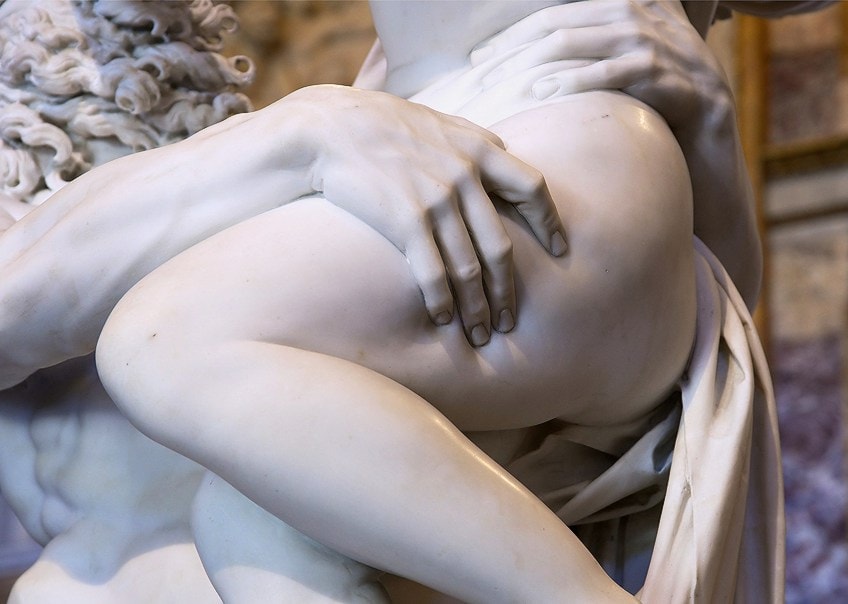
It is useful to draw your attention to another meaning associated with the texture art definition. The term “texture” also implies that the artwork can be perceived without being touched, and as such, the texture of the artwork should tell you what the subject or object represented is, without you having to touch it.
For example, to perceive the texture of a tree bark, one would imagine the rough surface of the tree, as well as the column-like form that the bark sits on.
Texture in painting is crucial to the perception of what it represents and can spark the imagination of the viewers by bringing the subject to life.
Different Types of Textures in Art
In art, there are two types of textures, namely: visual, otherwise described as “implied” or the “illusion” of texture, and physical, which we can touch and see. These types of textures are included on a two or three-dimensional surface.
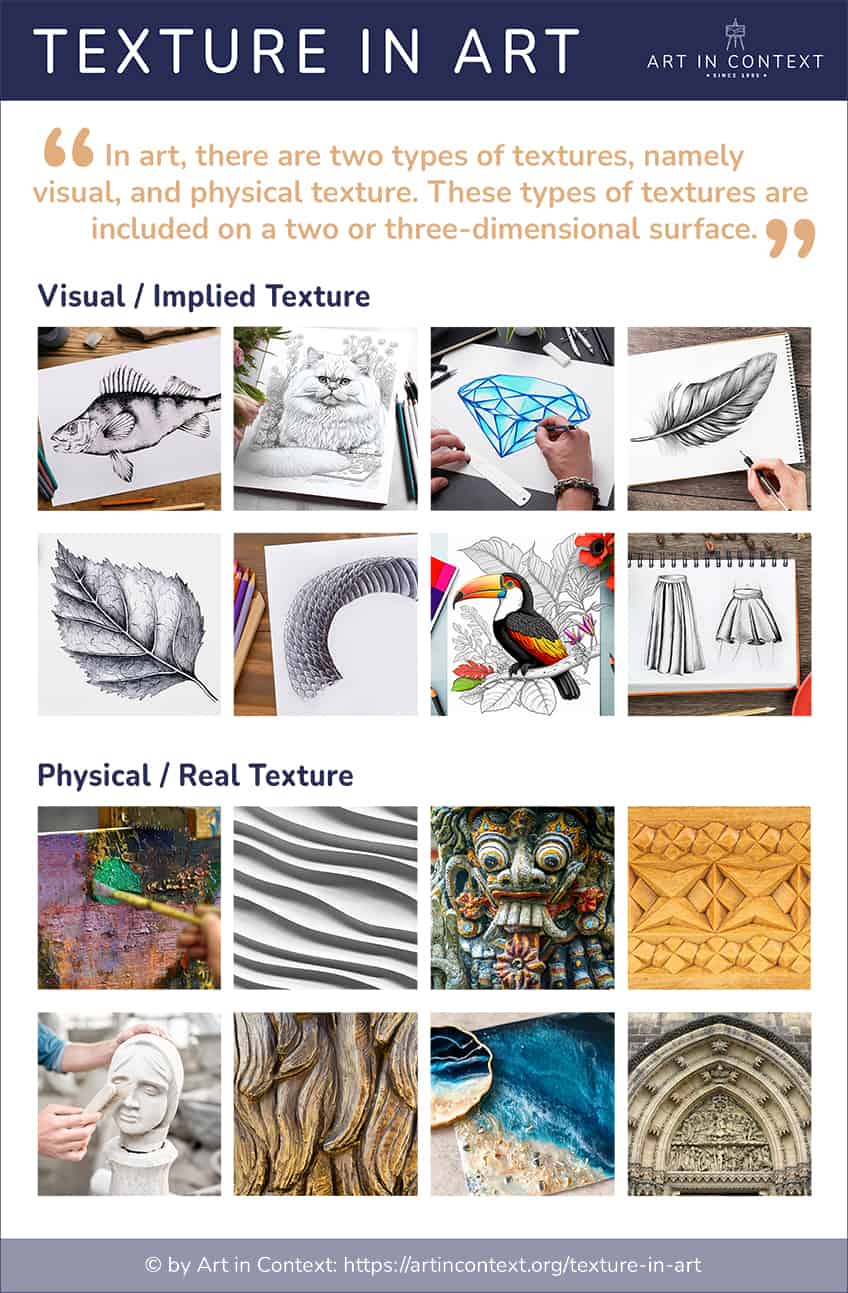
Texture in art also gives the viewer the impression of a three-dimensional object, figure, or pictorial space that can create depth and enhance certain qualities like contrast, movement, rhythm, and emphasis.
Visual Texture
Visual texture is otherwise referred to as “implied” or giving the “illusion” of a texture. This is usually recognized on a two-dimensional or flat surface like a canvas. The type of paint used to create a specific texture is also important. For example, there is oil, acrylic, tempera, or watercolor paints for artists to choose from and discern which is best for the kind of texture they wish to achieve.
Visual texture can be achieved in a multitude of ways that grant one the freedom of expression. If it is a painting, the common tools used to create texture include paint brushes, palette knives, sponges, or any other tool to apply paint.
Each type of paint will provide a different effect or texture on the canvas, the latter of which is another important aspect to consider since canvases or any other painting surface will have different surface textures. If one is painting on canvas paper, one can easily find a variety of textured canvas papers or prime the surface of raw canvas to create a smoother base and background for the rest of the composition.

Additionally, different painting techniques will inform the texture of the visual composition. Some of these, but not all, include impasto, which is a popular technique to create texture and involves the thick layering of paint on a surface. Dry brushing is another famous technique that involves the use of a dry paintbrush prepared with pigment that is applied directly to the surface.
Sfumato is another well-known texture technique, which was developed and refined by the famous Renaissance artist Leonardo da Vinci.
Finally, the pouring method is a more modern painting technique that emerged from Abstract Expressionism and was used widely by many artists to create smooth and flowing textures. Similarly, in drawing, a variety of textures can be created in a two-dimensional manner through different mark-making techniques. These range from cross-hatching to stippling and many more!
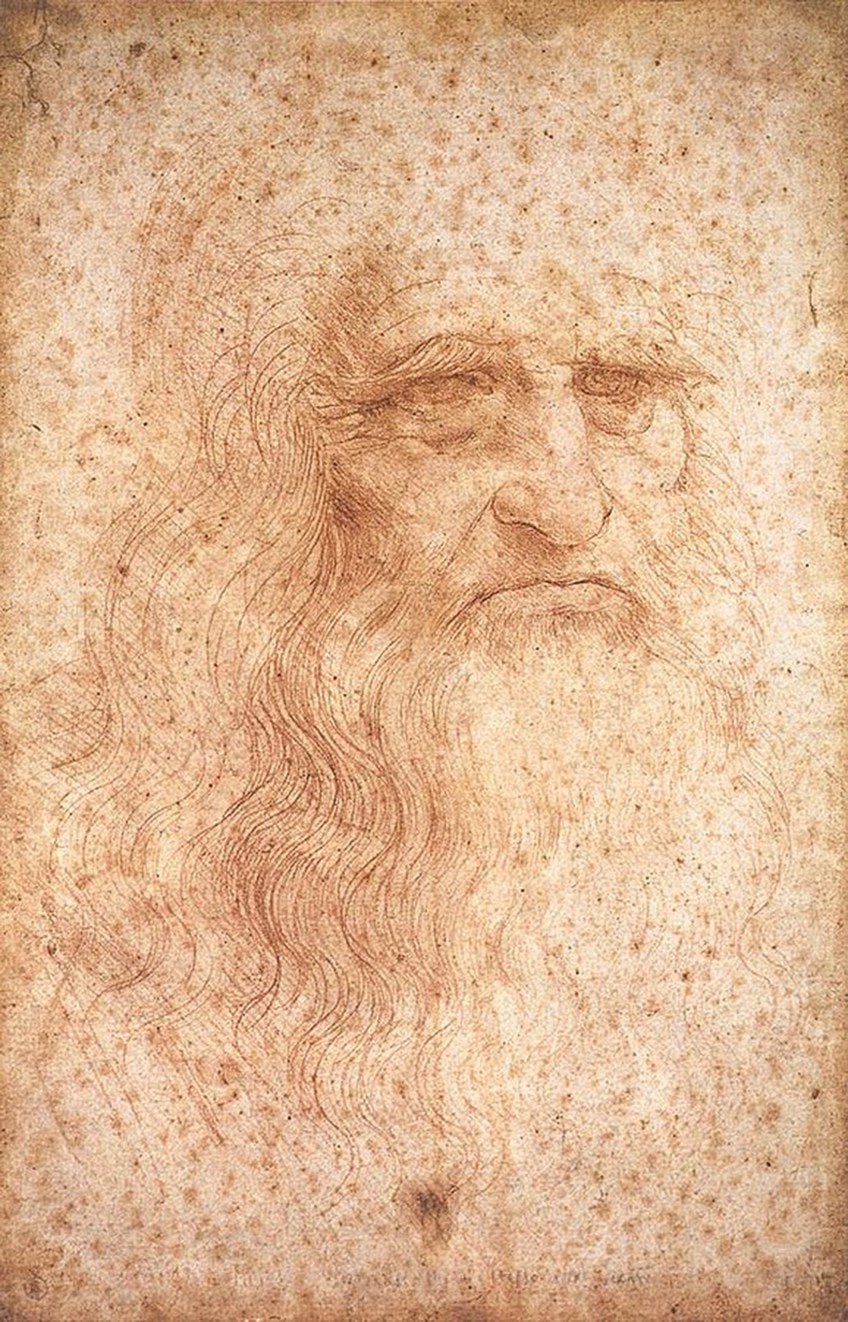
Techniques such as hatching and cross-hatching involve the creation of lines drawn parallel to one another and cross each another. Stippling is created by adding groups of dots to a specific section of a drawing to darken it and add a rough texture to the image.
Another popular method is scribbling, which involves the random application of lines or scribbles, while techniques like shading can be used to provide layered textures.
There are countless techniques that will create different textured effects in a composition. We will see these techniques in a variety of examples throughout art history. As we mentioned above, Leonardo da Vinci pioneered painting techniques like sfumato, which we see in his famous painting Mona Lisa (c. 1503-1506).
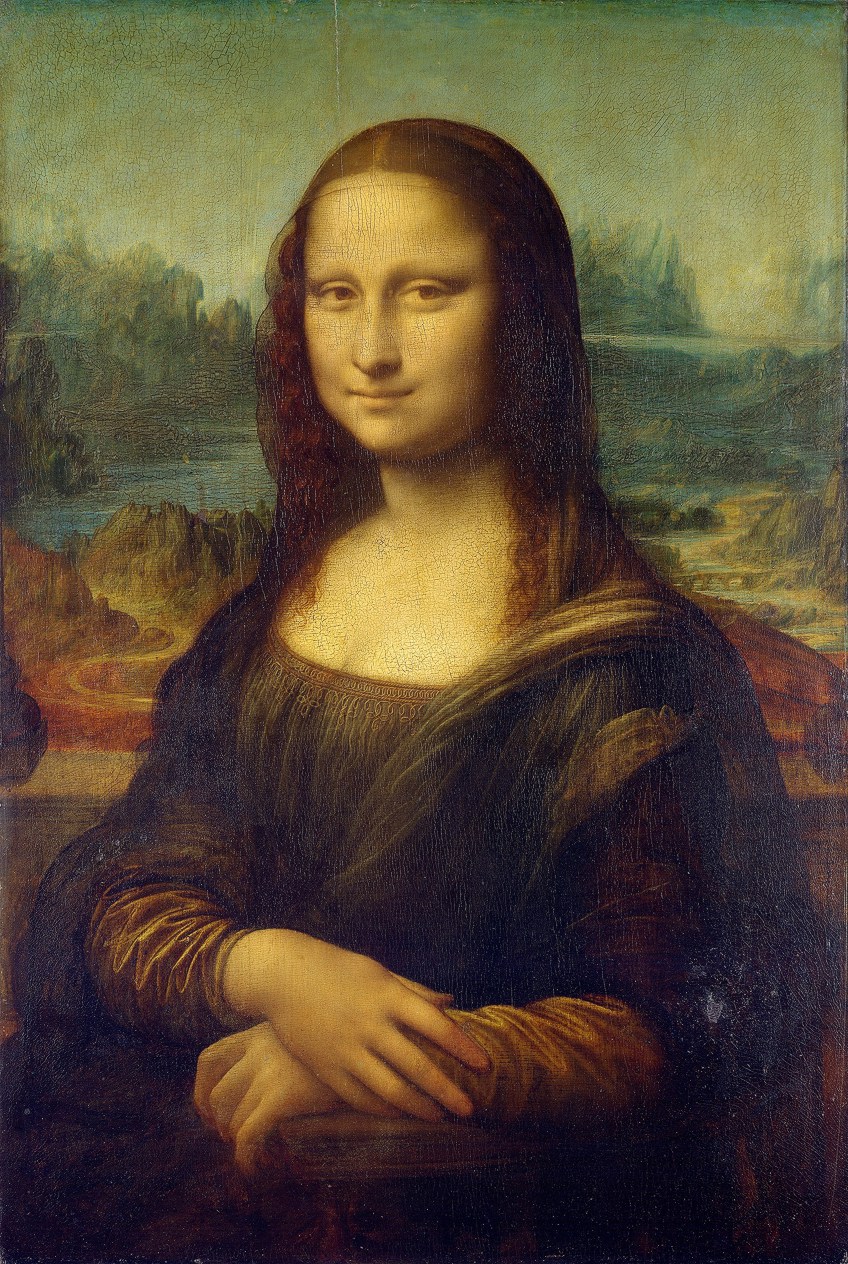
The sfumato technique gives the impression of a smooth texture, especially when skin is depicted. Different paint colors or tones are blended with one another in such a way that it produces a smoothed or “softened” effect, sometimes described as “blurred”.
This can be spotted in areas where the colors appear to change in tone and where there are no traces of the subject’s edges or outlines.
Another example includes Da Vinci’s Virgin of the Rocks (1483-1486) depicting the two infants, Jesus Christ and John the Baptist, Mother Mary, and Uriel the archangel. Here, we see texture depicted as smooth and fair skin tones, as well as in the surface of the rocks, which was depicted as rough using differing shades of brown and a uniform rigid form.
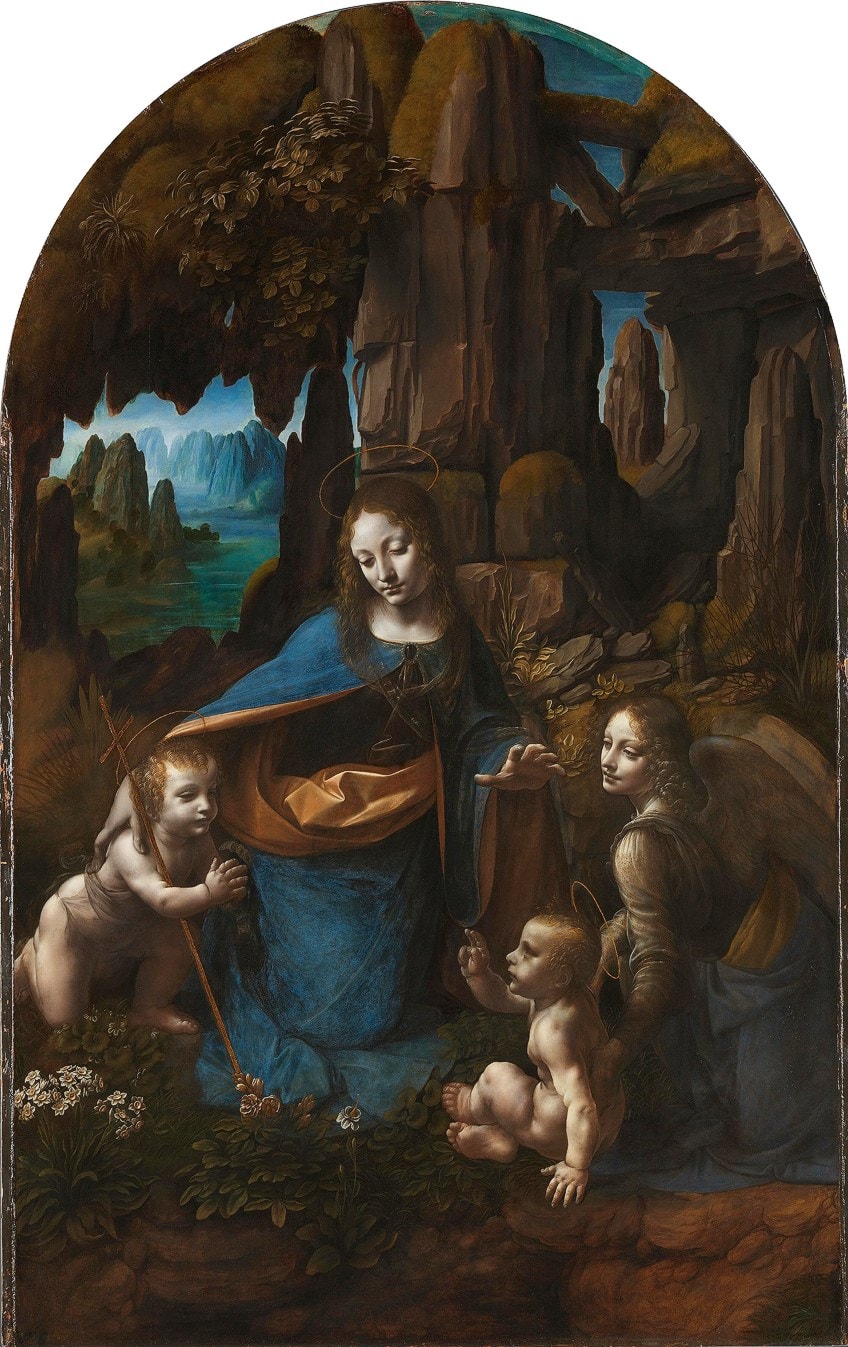
Other well-known Renaissance artists like Raphael and Giorgione also utilized the sfumato technique. For example, Raphael’s The Sistine Madonna (1512-1513) and Giorgione’s Youth Holding an Arrow (c. 1500) both depict the figures’ skin as smooth.
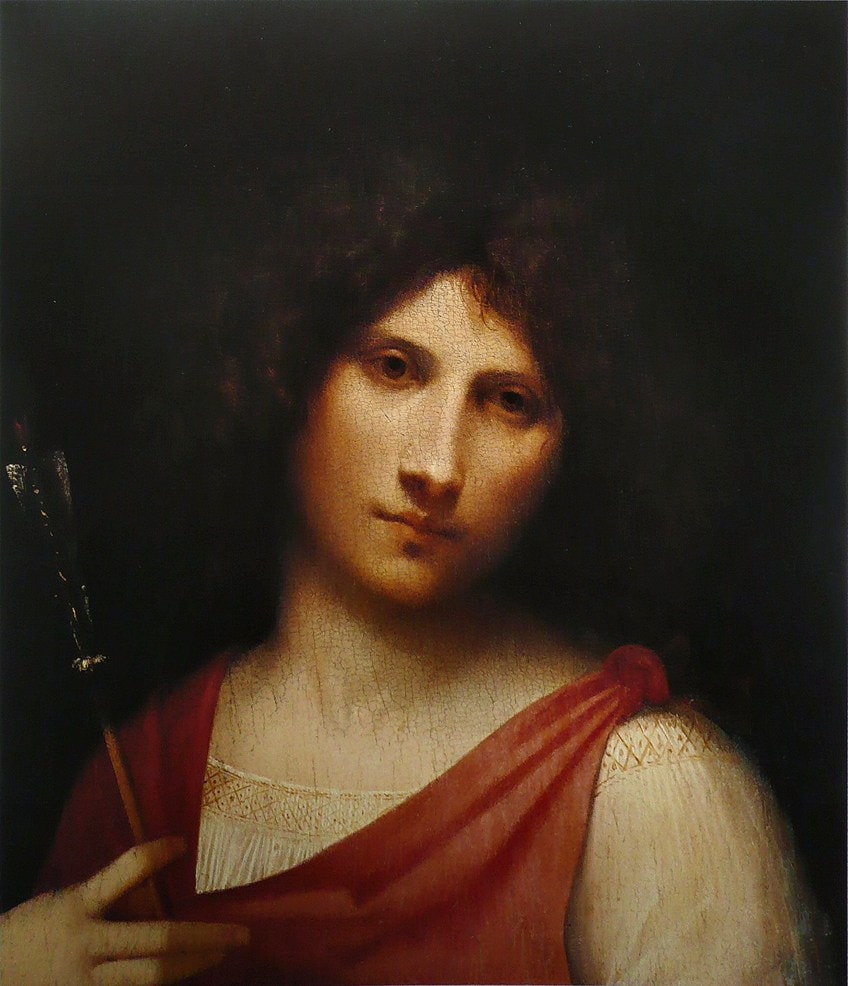
The skillful rendering of texture in the artwork, including the rendering of the clothing, curtains, bedding, and textures of the furs, metals, and jewels, among others, was a prominent feature in Renaissance art. The subject was portrayed with a high level of Realism, which also helped emphasize the textures of various elements.
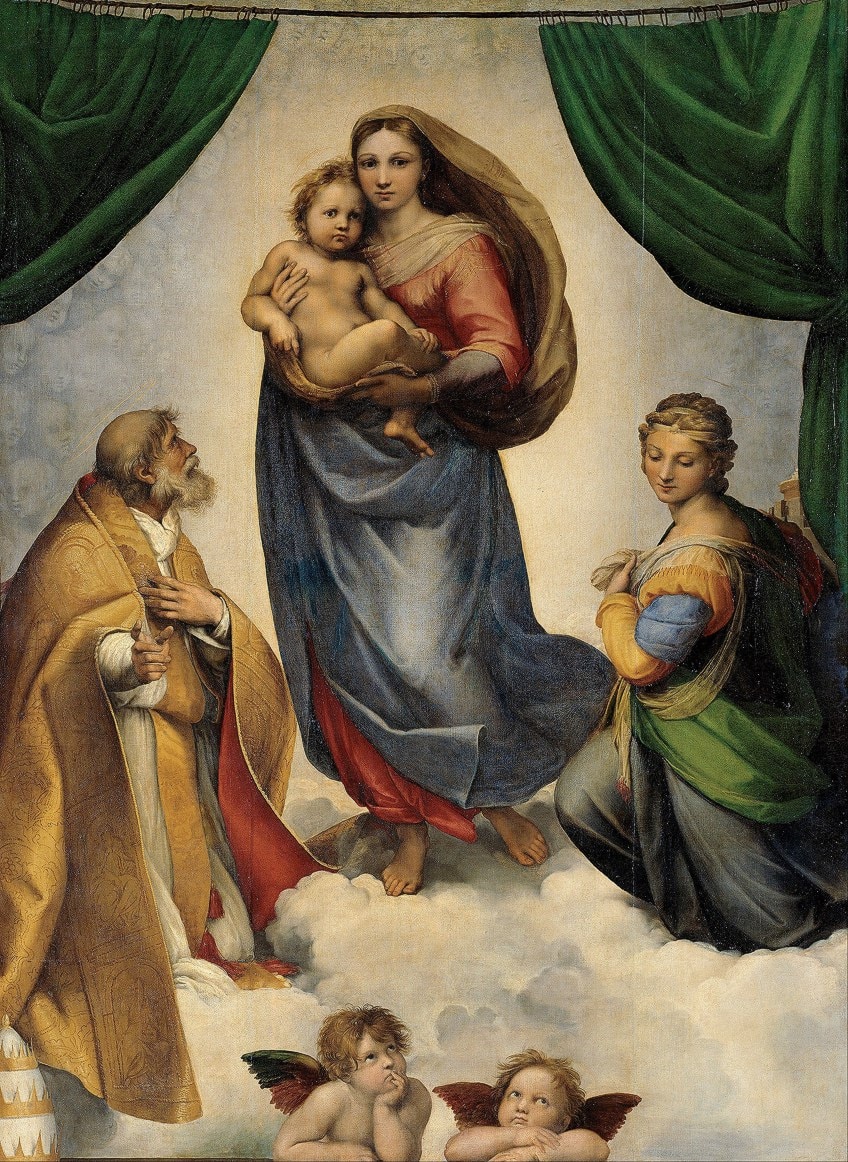
Additionally, the visual texture was masterfully employed by artists from the Dutch still-life genre of paintings during the 16th, 17th, and 18th centuries. Examples include the Dutch Golden Age painter Pieter Claesz, who was a pioneer in what was known as ontbijtjes pieces or “breakfast pieces”. His painting Still Life (c. 1625) provides the perfect illusion of a table setting and all its accouterments; a cut-open pie, various biscuits, bread, nuts, and olives, a knife, a spoon, silver plates, and goblets filled with what appears to be wine.
There is Hyperrealism about this painting and its objects, especially the lustrous qualities of the glasses and silver, which appear smooth, and the rougher qualities of the other food items like the bread and pie.
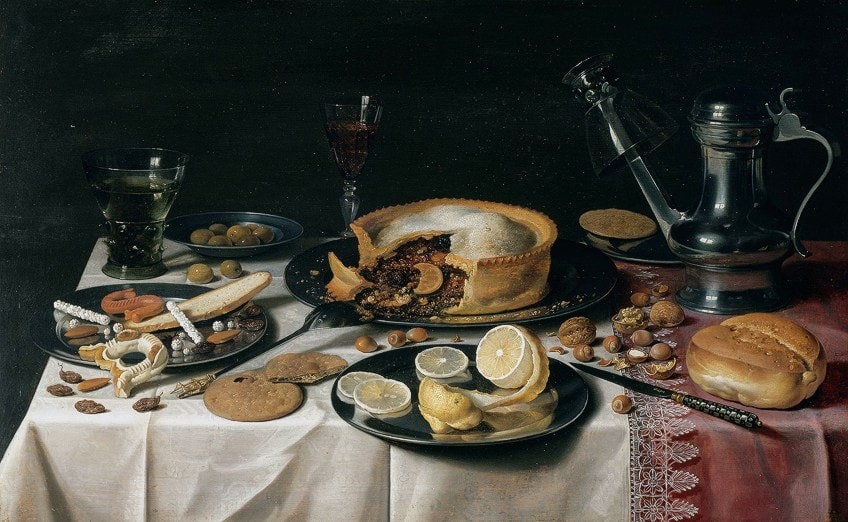
Physical Texture
Physical texture in art points to the physical feeling of artwork as something that has tactile qualities. This can be a sculpture or a painting on which the paint has been thickly applied. These include techniques like the impasto technique or it can be a sculpture made from any material like bronze, wood, marble, or even stainless steel.
A famous example of how physical texture can create a sensation and illusion of something is Jeff Koons’ Balloon Dog (1994-2001), including several of his other large sculptures, which mimic the surface quality of inflated balloons.
Koons’ sculptures are made from stainless steel, which invite us to want to touch it and feel for ourselves to determine whether it is in fact a real larger-than-life-sized balloon or a ruse of art.
Another example is thickly applied paint to denote a textured subject, for example, the bark of a tree, a pool of water, or tall stalks of grass, as we see in Joan Eardley’s texture artwork Seeded Grasses and Daisies, September (1960). This painting was a combination of textured abstract art that also becomes the subject matter.
If we look at art history after the Renaissance and the development of art in the Modern era, artists began to pay more attention to expressing their inner worlds and the fleeting nature of the world around them.
New painting techniques were utilized to evoke such emotions and ideas. Impressionist and Expressionist artists became famous for the way they utilized their paints to create textured and abstract art. Famous texture art examples include those of the French Impressionist Claude Monet, who sought to depict the world around him, almost like taking a photograph, en plein air, in the outdoor style. Using colors and texture, he gave us beautiful renderings of rays of sunlight and shade, which can be seen in his two famous works Impression, Sunrise (1872) and Sunrise, The Sea (1873).

In both paintings, Monet depicts the rays of sunlight on the sea’s surface in short, choppy, and textured, brushstrokes; most of his paintings were created in this way. These gestural painting qualities added more expression and feeling to the artwork, which differed from painting that was created with long, regular, and precise brushstrokes.
We will see these types of brushstrokes and textures in Vincent van Gogh’s artworks too, most notably in “The Starry Night” (1889) or his “Self Portrait” (1889).
Van Gogh created texture not only through a thicker application of paint but also by utilizing swirling shapes, which gave the composition a different meaning beyond what was real. For example, the sky in The Starry Night painting was depicted in rhythmic swirls, which leads us to feel emotional when observing a simple image of a night sky.
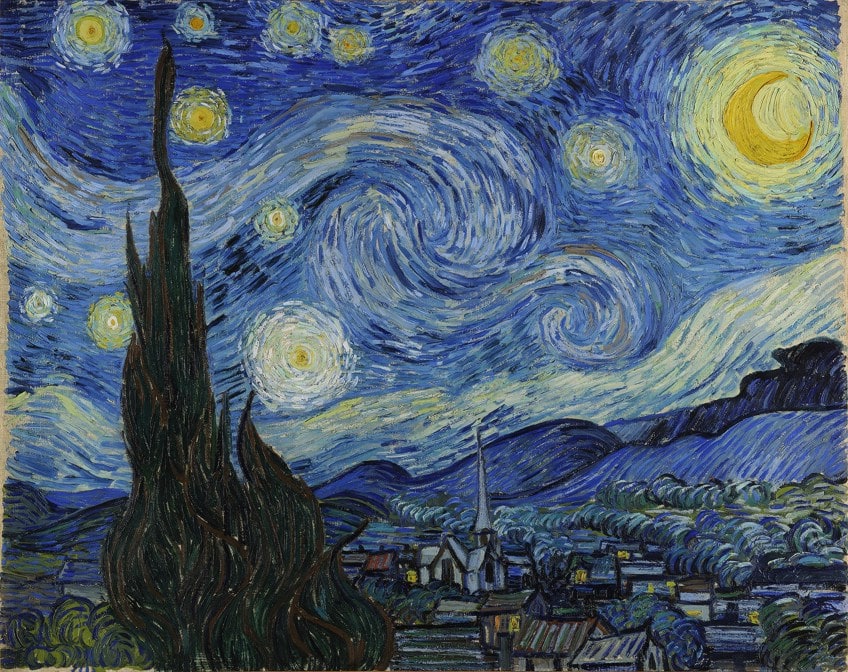
Other artists like the Romanticist J.W.M Turner combined colors, lines, and textures to create ambient compositions. In the famous oil-on-canvas Rain, Steam and Speed – The Great Western Railway (1844), Turner depicted the ideas of speed from the train and the elements of nature like rain in a flurry of thick and thin lines with various painting techniques.

Describing Texture in Art
Texture can be described in many ways and for any artist, art historian, or art enthusiast, some descriptive words will come in handy when exploring texture in art. While the most common words used to describe texture include smooth and rough, one can also appreciate a few additional words that can enhance your vocabulary and descriptions of different textured artworks.
| Smooth | Rough | Cut |
| Soft, glossy, shiny, lustrous, reflective, matte, silken, sleek, satiny, downy, leathery, furry, velvety, feathery, woolly, wrinkled. | Hard, coarse, raised, prickly, bristly, wiry, stony, frosted, glazed. | Scratched, sheared, incised, etched, engraved, chiseled, chipped, carved. |
Texture can thus be described in numerous ways that allude to different surface types, materials, and elements. From textures on physical man-made objects to textures from natural subjects and even intangible elements, artists can use a variety of terms and techniques to ensure that the audience understands the underlying message of the work.
A Summary of Texture in Art
Creating texture in art can be quite challenging, however, with careful thought and planning around the different surfaces in your composition, you can be confident that your textures will be communicated. Below, we have created a simple summary of texture in art with a few texture art examples that will help you grasp this important art element.
| Type of Texture | Characteristics | Texture artwork example |
| Visual texture (“Implied” or “Illusionistic”) | Texture that we can see, but not physically feel. It is commonly on a two-dimensional surface and gives the idea of texture or the illusion of texture. | Mona Lisa (c. 1503 – 1506) by Leonardo da Vinci Still Life (c. 1625) by Pieter Claesz |
| Physical texture | Texture with tactile qualities, that we can feel, usually this is more three-dimensional like raised paint on a flat canvas or a sculpted artwork. | Balloon Dog (1994 – 2001) by Jeff Koons The Starry Night (1889) by Vincent van Gogh |
Texture can be applied in a myriad of media, from painting and drawing to sculpture, and even digital art. We have also explored the two primary types of texture, namely, visual and physical textures, which each carry unique characteristics. Whether you are painting a draped dress or depicting a sliver of sunlight, texture can also be created with other elements of art to enhance your visual composition.
Read also our texture art web story.
Learn More About the Elements of Art
If you would like to learn more about the different elements of art, feel free to explore our series of informative articles on this essential topic! View our guide below for all you need to know about the elements of art:
Frequently Asked Questions
What Is Texture in Art?
Texture is an element of art that relates to the “surface quality” of an artwork. Texture can be created through numerous techniques and mediums to enhance the subject of an artwork and give it depth, meaning, and form. Creating texture is essential to helping viewers perceive and understand the subjects and objects in a composition.
What Are the Different Types of Texture in Art?
There are two main types of texture in art, namely, visual, implied, or illusionistic, which can be seen on a two-dimensional surface. There is also physical texture, which has tactile qualities and can be found on either a two or three-dimensional surface.
Alicia du Plessis is a multidisciplinary writer. She completed her Bachelor of Arts degree, majoring in Art History and Classical Civilization, as well as two Honors, namely, in Art History and Education and Development, at the University of KwaZulu-Natal, South Africa. For her main Honors project in Art History, she explored perceptions of the San Bushmen’s identity and the concept of the “Other”. She has also looked at the use of photography in art and how it has been used to portray people’s lives.
Alicia’s other areas of interest in Art History include the process of writing about Art History and how to analyze paintings. Some of her favorite art movements include Impressionism and German Expressionism. She is yet to complete her Masters in Art History (she would like to do this abroad in Europe) having given it some time to first develop more professional experience with the interest to one day lecture it too.
Alicia has been working for artincontext.com since 2021 as an author and art history expert. She has specialized in painting analysis and is covering most of our painting analysis.
Learn more about Alicia du Plessis and the Art in Context Team.
Cite this Article
Alicia, du Plessis, “Texture in Art – Exploring the Element of Texture in Art.” Art in Context. March 17, 2022. URL: https://artincontext.org/texture-in-art/
du Plessis, A. (2022, 17 March). Texture in Art – Exploring the Element of Texture in Art. Art in Context. https://artincontext.org/texture-in-art/
du Plessis, Alicia. “Texture in Art – Exploring the Element of Texture in Art.” Art in Context, March 17, 2022. https://artincontext.org/texture-in-art/.


